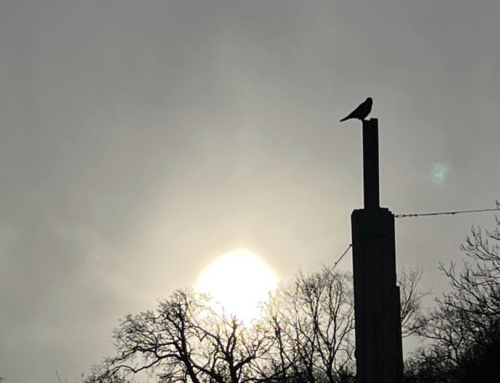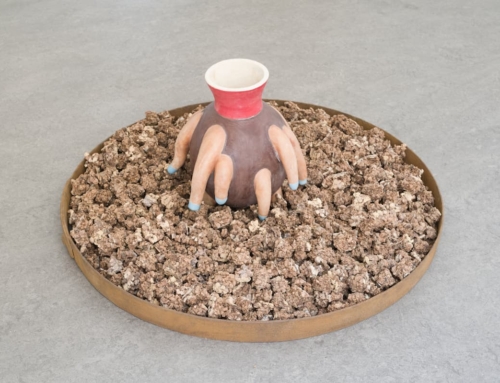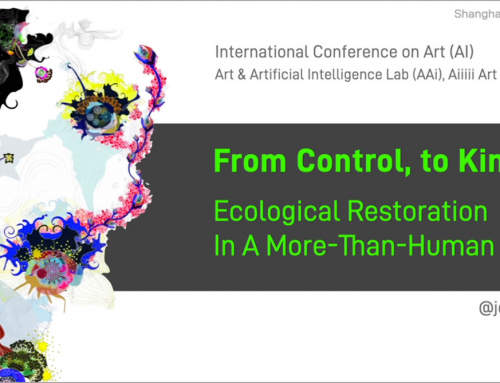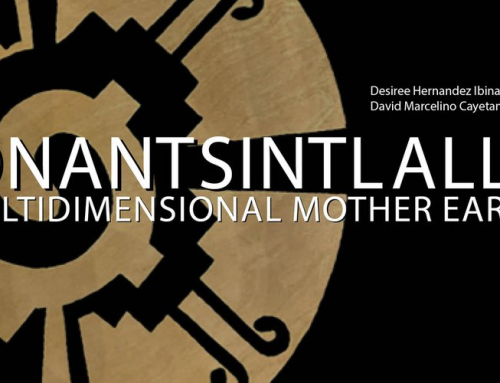On the occasion of the publication of #ThackaraThrive in Spanish, I did an interview for Experimenta with Dr. Eugenio Vega Pindado. Here below is the English version.
Q1: This is one of the first interviews with John Thackara in a Spanish magazine. What do you tell to our readers about the main motivation for your approach of the problems discussed in this book?
A: To people who fear that there no escape from an economy that devours nature in the name of endless growth, I argue that another world is not just possible – it is already happening. I know this to be true because I’ve spent 30 years traveling in search of stories about people tackling timeless needs in new ways: restoring the land, sharing water, making homes, growing food, designing clothes, journeying, and caring for each other. Some of these activities can sound unfamiliar – for example soil restorers, or river keepers, or social farmers. But the people I meet are not super-heroes. They are regular people doing inspiring work in these strange times. That said, I do emphasize the power of small actions to transform the bigger picture – especially when their efforts are connected together in networks like food commons, or social farming, or fibersheds. A big inspiration for my book is the work of Amador Fernández-Savater. He advises us, “don’t fight directly for power, be the message-bearer of a new concept of the world” – and that’s what the book tries to do: Change our expectations of what’s possible.
Q2: How to Thrive in the Next Economy it is an entertaining book, it is not a simple academic work. There in its pages a clear objective to reach all kinds of readers: Have you a strong desire to extend these ideas among a very wide audience?
A: I try to pose questions in a way that enables people from diverse backgrounds to join the conversation. So I avoid jargon and buzzwords, obviously. But I also use real world stories as examples of what would otherwise come across as abstract issues. Food systems are a good example: For most people – and I include myself – something called a “food system” is abstract, and hard to grasp. What does such a thing look like? How dos it behaves? Rather than answer in a theoretical way, I write a soup kitchen, or a community bakery, or vegan restaurant, or a food distribution website – and explain that these real-world activities are all elements of this mysterious thing called a food system.
Q3: You insist that it is not possible to grow production or consumption in a finite world, consisting of physical and limited element. What do you thing will happen the next decade?
A: So here’s a confession: I don’t know what will happen in ten years from now! But, for me, that’s not the point. I encourage my readers to focus on what’s happening now – but below the radar, away from mainstream media, on the edge of their familiar world. These edge projects and networks, when you put them together, add up to a joyful new story about what an economy is actually for. In place of an obsession with stuff, money, and endless growth. Growth, in these projects, has a new meaning: soils, biodiversity and watersheds getting healthier, and communities more resilient. Its core values are stewardship and health, in place of extraction and decay.
Q4: You write about how important is the change coming to the whole economic system. Sometimes it seems that solutions are not easy to find. What role can designers, and artists to contribute to positive change in this next economy?
A: Many designers and artists should be excited by the sheer variety of work to be done in bringing these new projects and places to life. Maps of a bioregion’s ecological assets are needed: its geology and topography; its soils and watersheds; its agriculture and biodiversity. The collaborative monitoring of living systems needs to be designed – the interactions among them, and the carrying capacity of the land, together with feedback channels. Spaces and places that support collaboration need to be identified and, where needed, adapted—from maker spaces to churches, from town halls, to libraries. New collaboration and peer-to-peer platforms are needed to help people to share resources of all kinds—from land, to time and knowledge. These are all design tasks – at least in part – even if they do not appear on the curriculum of most design schools or in the brochures of design companies.
Q5. There is also a literary feeling when you explain several examples, seeking personal connections, like a traveler who enters a path leading, not without much difficulty, to a sustainable society. The description of first pages in chapter 5 (Feeding. From social farming to food as commons) is very emotional; it shows the complex diversity of modern life in a vivid way. What is in this book autobiographical? To what extent is a sort of personal diary about the impact of this great social transformation?
A: The philosopher Joanna Macy the appearance of this new story as the ‘Great Turning’. My book is just one among many examples of this new understanding: that we are not separate or apart from plants, animals, air, water, and the soils. I experience elements of this reality – that no organism is truly autonomous – when I walk in wild places in the Cevennnes – the area of France where I live. I’m also learning from meeting researchers – people who do deep study of Gaia theory, systems thinking, and resilience science. – that our planet is a web of interdependent ecosystems. People who investigate everything from sub-microscopic viruses, yeasts, ants, mosses, lichen, slime moulds and mycorrhizae, to trees, rivers and climate systems, are all conributing to this new new story – the story that all natural phenomena are connected. Their very essence is to be in relationship with other things—including us.
Q6. Your book explores practical innovations in sustainability worldwide as small stories with a common link. Which of them, do you consider the best examples of that change is on the horizon?
A: The sheer variety of projects and initiatives out there is, for me, the main story. No single project is the magic acorn that will grow into a mighty oak tree. We need to think more like a forest than a single tree! If you look at healthy forests, they are extremely diverse—and we’re seeing a healthy level of diversity in social innovation all over the world. Many people say we need to focus on solutions that scale, but to me that’s globalisation-thinking wearing a green coat. Every social and ecological context is unique, and the answers we seek will be based on an infinity of local needs.
Q7. An important aspect is the emphasis on the recovery of the city as a place for more sustainable forms of life. Examples of Fresno and Cleveland, as well as many others, insist on a revolution “not in the countryside”, but in our cities. Could this stop big interests that shape our current urban environment?
A: When I meet with city planners or managers I like to start with two questions: “Do you know where your next lunch will come from?” and, “Do you know if that place is healthy or not?” These unexpected questions are a trigger to re-focus on the health of places that keep their city fed and watered. Within this novel framework, new opportunities for innovation emerge- such as Urban farming. Innovation here is not much about high-tech control systems. It’s more about new ways to share resources, and collaborate to get the work done. New kinds of enterprise are needed, too: food co-ops, collective kitchens, community dining, edible gardens, new distribution platforms, different ways to share resources, and collaborate. These are all urban design opportunities.
Q8. It is very outstanding the chapter dedicated to food. The need for a new way of organizing production and distribution of food seems inevitable. Do you think agricultural organizations like “La Via Campesina” can lead this process of change, when they have in front large farming companies and, to some extent, organizations such as FAO?
A: La Via Campesina faces huge obstacles, of course. The industrial agriculture system, especially, can look like an all-powerful monolith. But BigAg faces multiple and I believe terminal crises that it tries to keep hidden: a crisis of productivity; a crisis of profitability; and above all a crisis of legitimacy. These crises are structural; they are hard-wired features of a faulty system. A growing number of people in suits are coming round to the view that an agro-ecological approach the way of the future, not an industrial-productivist one. A radical shift in worldview is happening – away from a narrow focus on the production of food, towards a whole systems approach in which the interests of farm communities, the land, watersheds, and biodiversity, are all considered together as inter-dependent parts. The best way we can help movements like La Via Campesina is by doing similar work in our own places – finding and connecting with the grassroots projects of the kind I write about in the book : groups restoring ecosystems, lakes and watersheds; people hacking everything from computers to sanitation systems; the smart ways that urban farmers, seed bankers, local currency designers and community doctors do their thing. This movement doesn’t have a name, a logo or an office. But it does have an umbrella concept that can make sense of the work we do as designers in this swarm: the idea of the Commons. The core value of commoning is stewardship rather than extraction – it’s the opposite of the drive to turn everything into money. Very little of this activity is described as ‘design,’ but most of it can benefit from our participation. This is where design needs to be.
Q9. Among the most innovative aspects of the book is the need of a new language. The way we refer to what happens, must change, moving from “do less harm” to “leave things better than they are”, if we want some kind of positive transformation. How can designers contribute to this paradigm shift in communication?
A: For one thing, designers should do less communicating! At least, of the point-to-mass, one-to-many kind such as posters or media campaigns telling people how to behave. The priority is not messages or concepts or plans. He priority is to foster ecological emptahy and, as a result of that, better and richer connections between people and places. Ecological empathy is latent in us all. It just needs to be released. What we need are positive triggers that reawaken a joyful sense of being at home in the natural world. This is where art and storytelling come in. They can tweak our interest, redirect our attention, and start conversations in ways that hectoring communications never do. Marcel Proust memorably said “The real act of discovery consists not in finding new lands, but in seeing with new eyes”.
Q10. Large companies are using people’s concern for the environment to reorient its trade policies and maintain high levels of consumption. Is it possible that industry (obsessed with growth and consumption) can drive some sort of positive change towards a sustainable society?
A: I did indeed have a transformational experience at a famous home furnishings giant in Sweden. This famous company has made thousands of rigorously-tested improvements that are recorded on what they call a “list without end” – but the one thing this huge company has not done is question whether it should grow. On the contrary: It is committed to double in size by 2020. By that date, the number of customers visiting their giant sheds will increase from 650 million a year at the time of writing to 1.5 billion a year. Sitting there, it hit me that however hard they work, however many innovations they come up with, the net negative impact of their firm’s activities on the world’s living systems will be greater in the years ahead than it is today. And all because of compound growth. This was the moment when I realised that being committed to “do less harm” is meaningless if your firm simultaneously committed to grow. That course will inevitably leave things worse.
Q11. Related to the above question, what role can play cooperatives, social enterprises and other social business models in Western economies in a market that needs high levels of consumption and endless growth to survive?
A: The commons is an idea, and a practice, that generates meaning and hope. I like the way Silke Helfrich talks about the Commons as “all the things that we inherit from past generations that enable our livelihoods.” Seen through that lens, the Commons can include land, watersheds, biodiversity, common knowledge, software, skills, or public buildings and spaces. The important thing is that the commons are a form of wealth that a community looks after, through the generations. The idea embodies a commitment to ‘leave things better’ rather than extract value from them as quickly as possible. None of this is new, by the way. The commons goes back an awfully long way. It describes the way communities managed shared land in Medieval Europe. Even earlier history, too, is filled with examples of communities managing common resources sustainably. Examples of water being shared as a commons date back 8,000 years. One of my inspirations on this subject, commons advocate David Bollier, reckons that, even today, two billion people depend on natural resource commons for their everyday survival—farmland, fisheries, forests, irrigation water, wild game.
Q12. Throughout the book appears frequently an allusion to a world without markets, where trade can be resolved through barter, or alternative procedures not monetized. To what extent this new culture, needed to reduce dangerous impacts, can cope tremendous force money has in today’s society?
A: I’m not sure we’re talking about a new culture here. The care-based economy has existed throughout human history—looking after each other, and the land, in a multitude of ways, many of which don’t involve paid-for work. An important German writer called Ina Pratetorius has recently argued for a care-centered economy in the sense of caring for the world and not only nursing and social-work activities or housework in the narrow sense. Theodore Shanin, who has been called the peasant’s philosopher, makes a similar point: so called peasants, farmers and poor people have been stewards of their commons for generations – the land, the water and the air. Mmdern, industrialised mass-production farming made it harder and harder to do their job – and we now have the challenging but pleasant task to reinvent that relationship for these new times.
Q13 .What could give examples of urban projects that experienced in writing the book?
A: The most important urban projects, for me, put the vitality of social end ecological systems at the top of the agenda. In planning terms, this translates into support for sites of social creativity: Maker spaces, recycling projects, craft breweries, bake houses, productive gardens, community kitchens, and the like. Every city needs a lot of these and other commons-based spaces. In their business support programmes, cities need to focus on platform co-ops in which value is shared fairly with the people who make them valuable. “Value” here means shelter, transportation, food, mobility, water, elder care – the lot.
Q14. In recent decades there has been a kind of “green or friendly” market for those consumers concerned with many aspects of quality of life and environment.Will these consumers would be able to go further, to give up the current levels of comfort for a more reasonably sustainable world?
A: Buying and consuming stuff doesn’t make people happy. Being connected makes people happy – with each other, and with the living systems.
Q15. Mr. Thackara, your career began in activities very close to conventional design. What has make you change to reach a more complex analysis, and a more ambitious position? What role does Doors of Perception play in this new situation?
A: Doors of Perception is about three things: Changing the way we look at a situation; connecting you with people who are not your typical partners or suppliers; and helping you move on from just talk, to experimental action. As a coach, I help groups turn “would-be-nice” ideas into service prototypes that can be the basis of sustainable livelihoods and new kinds of business. These activities are subsets of a bigger challenge for everyone and not just designers: What does it take to be a better ancestor? By what practical means can we leave the world better than we found it?
#





